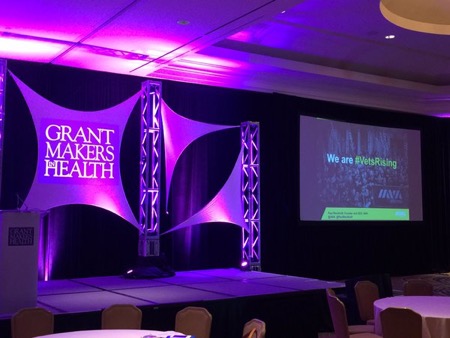Funding’s Not Forever, But Foundations Must Help Grantees Manage Transitions
Resource type: News
The Atlantic Philanthropies |

 By Maryann Jacob Macias, Associate Programme Executive
By Maryann Jacob Macias, Associate Programme Executive
Change is always hard, especially when it involves bringing something one has invested in to an end. It is difficult for us as grantmakers adjusting to new circumstances – for our foundation as priorities shift, and for grantees dealing with the end of a project or a pivot in a funders’ emphasis.
In the philanthropic field the emphasis is so often on getting something started; identifying a need or an opportunity, strategizing a possible solution or initiative, and lobbying for the funds and organization to implement it. But what are much less discussed are endings.
The Atlantic Philanthropies is hoping to change that, and to add the notion of “endings” to the conversation. Ending is certainly not a new idea to any funder—all grants end eventually, and strategy areas often shift among foundations as success is scaled, and new opportunities to facilitate change arise. Less often, foundations conclude grantmaking altogether. In light of this, Sara Kay (former head of advocacy and health equity programs) and I represented Atlantic at the Grantmakers In Health conference in Coronado, California, where we co-facilitated a breakout session with Kim Moore of the United Methodist Health Ministry Fund, and Kate Weiland and Marybeth Sharpe (formerly) of the Gordon and Betty Moore Foundation. The session was titled: “Soft Landings: Approaches to Managing Foundation Transitions.”
We discussed endings in their different manifestations, whether it is concluding grantmaking in a specific geographical or program area, changing priorities of a grantmaker, or a funder that has decided to exit grantmaking altogether. The purpose of the session was to share approaches for still maximizing impact during these often difficult periods of transition.
Atlantic, As a Case Study
In its more than three decades of grantmaking, The Atlantic Philanthropies has made significant investments – or “big bets” – in supporting the expansion of LGBTQ rights in South Africa and the Republic of Ireland; the development of a public health system in Viet Nam; and enhancing access to affordable healthcare in the United States. But, as a limited life foundation, Atlantic also had in place a roadmap and a timeline for exit from these projects. Could these big bets serve as a genesis for potential lessons to foundations considering, or in the process of, transition?
What followed was a robust discussion about concluding this type of work responsibly, and respectfully, with minimal disruption to grantees and the field. Unsurprisingly, there was tremendous interest in ensuring grantee sustainability, as well as in staff retention. While Atlantic aimed to minimize disruption among the field and our grantees as we concluded grantmaking, this was predictably more complicated in our global offices, where Atlantic funding was often in excess of 50 percent of funding of those programs. That is a very steep cliff.
To this end, all of our concluding grants were structured with sustainability in mind. For example, several culminating, capstone grants came with significant match requirements, thereby enabling grantees to leverage Atlantic’s final investments in pursuit of new funding partnerships for the future.
Timing and Communication
Two key takeaways were on timeliness and clear communication among grantees and staff. Atlantic’s path to exit was communicated with the intention of initiating sustainability strategies for our grantees, and providing staff with enough time and support to consider their next professional phases.
A surprising number of questions from attendees also came up around the monitoring of existing grants. Given our diminishing staff ranks, how does a limited-life foundation handle their remaining active grants? Does a knowledge gap exist? Were staff that had been retained overloaded by management of these grants? How do you manage responsibly when staff with substantive knowledge have departed?
As Atlantic is currently addressing these very issues, we’ve asked some key former staff to serve as consultants on grants where knowledge gaps may exist, and that may be considered complex in nature. Existing staff have taken on more fluid roles, using a varied skill set to efficiently manage this final phase.
But Atlantic’s story hasn’t concluded yet and we are still thinking about many of these important questions. We invite you to look out for our evaluation report on limited life philanthropy in mid-2016, which will provide key insights on how to exit efficiently, and responsibly, as well as lessons on what could be done differently.
We have a lot of learnings left to share and questions to consider, but the universal solution we can impart now is this: communicate early and clearly with staff and grantees.
Paul Rieckhoff, founder of Iraq and Afghanistan Veterans of America, said in his conference keynote address, “Good philanthropy is about the impact, not about the donor.” We couldn’t agree more. Further, grantmaking is about people: those doing the work, and those benefitting from the work. Our advice to others going down this path is to always keep this in mind when formulating your exit strategies to ensure maximum impact in the time remaining.
Endings are every bit as important as beginnings and the same level of institutional attention and care should be paid to them. As I noted earlier, grantmaking is often about getting projects and programs off the ground. But what goes up must also be given a gentle and encouraging place to land.
Maryann Jacob Macias is Associate Programme Executive at The Atlantic Philanthropies.